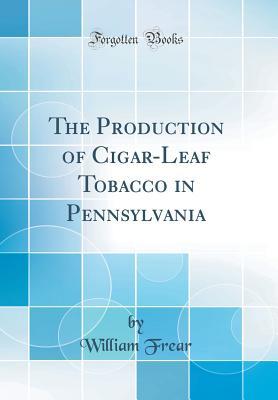Full Download The Production of Cigar-Leaf Tobacco in Pennsylvania (Classic Reprint) - William Frear | PDF
Related searches:
Jan 28, 2011 grab a small clump of filler leaf and make it tube-like.
However, decreased production in this traditional area along with increased demand for natural leaf cigar wrappers has required tobacco dealers to look at other tobacco-producing areas for production of this type.
Opportunities for the production of cigar-leaf tobacco in east texas and alabama by whitney, milton.
The history of commercial tobacco production in the united states dates back to the 17th century when the first commercial crop was planted. The industry originated in the production of tobacco for pipes and snuff. Different war efforts in the world created a shift in demand and production of tobacco in the world and the american colonies.
Dec 21, 2017 tobacco leaves are produced for different final products such as cigarettes, cigars and smokeless tobacco.
The country operates two tobacco monopolies – regie nationale des tabacs et allumettes (rnta) based in tunis and manufacture des tabacs de kairouan (mtk) located in kairouan. Similar to other north african monopolies, rnta and mtk account for all local production and import of international brands.
North carolina lies in the virginia-carolina tobacco belt and topped the list in 2016 with a tobacco.
Supersedes farmers' bulletin 416, the production of cigar-leaf tobacco in pennsylvania.
Think of a fuente fuente opus x with its unique wrapper, grown under shade that is especially calibrated to create its distinct flavor profile. The filler is usually a blend of different leaves chosen for special characteristics they possess, like strength, spice, and flavor in general.
When the tobacco is ready to be rolled into cigars the leaves are sorted again and divided up into three categories: filler.
Tobacco is a plant whose leaves are used for the production of cigarettes and cigars. It is a there are three types of cigar leaf tobacco: (l) cigar filler tobacco.
-air cured tobacco leaves, seeds with growing instructions are available here� havana tobacco seeds are good for making cigars, particularity cigar wrappers.
Opportunities for the production of cigar-leaf tobacco in east texas and alabama.
Cigar glue is used to prevent the wrapper from coming off the head of the cigar after it is opened (clipped).
In 1879 cuban cigar-leaf tobacco was grown successfully on a commercial scale near willis in montgomery county, but after a few years commercial production in that area ceased until 1891, when it was renewed with considerable success.
However, only the best tobacco leaf primings for making cigars.
We are dependent to-day upon tobacco from foreign countries for most of the wrappers and fillers used in the manufacture of the better class of cigars. It has been demonstrated that there are certain well-defined areas in this country where the sdl and climatic conditions are favor-.
Rehandling and fermentation of tobacco leaf prior to manufacture. Is intended for the cigar, pipe smoking or cigarette trade; but the treatment of the leaf after.
Binder - the portion of a tobacco leaf that is rolled around the filler to hold it together.
Scandinavian tobacco group produces cigars in the dominican republic, honduras, nicaragua, indonesia, the netherlands, belgium, denmark and the united states; it also makes pipe tobacco and fine cut tobacco.
The principle raw material of the cigar is the leaf of the tobacco plant (nicotiana tabacum). The tobacco plant grows in many climates, but the finest cigar tobacco is grown in cuba, jamaica, and the dominican republic. A cigar requires three kinds of tobacco leaf as its raw material.
4 billion ryo cigarettes were smoked in 1994 (maxwell tobacco fact book, 2000). A cigar is any roll of tobacco wrapped in leaf tobacco or any other.
Cigar-binder types are those which produce chiefly to- bacco suitable for cigar- binder pur- poses.
Of course, one of the most important elements to creating great cigars is the raw materials. Taste, aroma, ash color and burning qualities are directly related to the soil and climate conditions. The size, color and texture of a cigar leaf is determined by the variety of seed planted. Tobacco seed planting time typically encompasses the months of september and october, and the seeds germinate and grow for about six weeks.
That the process for tobacco fermentation is used on other consumable products is no secret. You’ll see that cigars are often compared to wine – and fermentation is another process they share. Wine, kombucha, vodka, sauerkraut, cheese, and pickles are all fermented at one point in their production. The use of bacteria, alkaloids, and other factors will refine the wild flavors and bring a finished product.
In the beginning, most tobacco production was concentrated in the fertile land of the recôncavo baiano. After the dutch were expelled in the 17th century, legislation was put in place to help regulate tobacco production. There are about 135,000 farmers currently producing tobacco across brazil.

Post Your Comments: